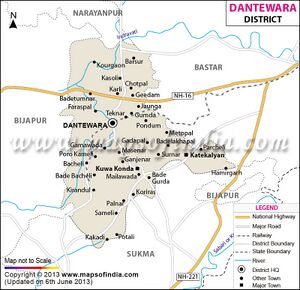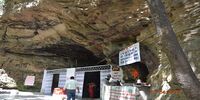Pandava Parvata
| Author:Laxman Burdak, IFS (R) |
Pandava Parvata (पाण्डव पर्वत) is name of one of five hills situated at Rajgir in Bihar, India. Mahabharata calls it Pandara. A Cave in Panna district is known by name Pandava. There is also a hill by this name in Dantewara district of Chhattisgarh.
Origin
Variants
- Pandavaparvata (पाण्डव पर्वत) (AS, p.537)
History
Alexander Cunningham[1] mentions.... Kusagarapura was the original capital of Magadha, which was called Rajagriha, or the " Royal Residence." It was also named Girivraja, or the "hill-surrounded," which agrees with Hwen Thsang's description of it as a town " surrounded by mountains." Girivraja[2] is the name given in both the Ramayana and the Mahabharata to the old capital of Jarasandha, king of Magadha, who was one of the principal actors in the Great War, about 1426 B.C. The Chinese pilgrim Fa-Hian[3] describes the city as situated in a valley between five hills, at 4 li, or two-thirds of a mile, to the south of the new town of Rajagriha. The same position and about the same distance are given by Hwen Thsang, who also mentions some hot springs, which still exist. Fa-Hian
[p.463]: further states that the " five hills form a girdle like the walls of a town," which is an exact description of Old Rajagriha, or Purana Rajgir, as it is now called by the people.
A similar description is given by Tumour from the Pali annals of Ceylon, where the five hills are named Gijjhakuto, Isigili, Webharo, Wepullo, and Pandawo[4]
In the Mahabharata the five hills are named Vaihara, Varaha, Vrishabha, Rishi-giri, and Chaityaka;[5] but at present they are called Baibhar-giri, Vipula-giri, Ratna-giri, Udaya-giri, and Sona-giri.
In the inscriptions of the Jain temples on Mount Baibhar, the name is sometimes written Baibhara, and sometimes Vyavahara. It is beyond all doubt the Webharo Mountain of the Pali annals, on whose side was situated the far-famed Sattapanni Cave, in front of which was held the first Buddhist synod, in 543 B.C. This cave, I believe, still exists under the name of Son Bhandar, or " Treasury of gold," in the southern face of the mountain ; but following Hwen Thsang's description, it should rather be looked for in the northern face. In the Tibetan Dulva it is called the " Cave of the Nyagrodha" or Banian-tree.[6]
Ratnagiri is due east, one mile distant from the Son Bhandar Cave. This situation corresponds exactly with Fa-Hian's position of the Pippal-tree Cave, in which Buddha after his meals was accustomed to meditate.
पाण्डव पर्वत पन्ना
विजयेन्द्र कुमार माथुर[7] ने लेख किया है ...1. पाण्डव पर्वत (AS, p.537) - पांडव नामक एक अति प्राचीन स्थल पन्ना-छतरपुर मार्ग में स्थित है. कहा जाता है कि पांडवों ने अपने वनवास काल का कुछ समय यहां व्यतीत किया था. यहां एक 30 फुट लंबी गुफा के अंदर, जो अति प्राचीन जान पड़ती है, कुछ अर्वाचीन मूर्तियां तथा शिव प्रतिमाएं अवस्थित हैं. गुफा की प्रस्तरभित्ति में प्रकोष्ठ के समान एक संरचना दिखाई पड़ती है. आसपास के जंगल में अनेक वन्य पशु-पक्षियों का बसेरा है. कुछ अन्य टूटी-फूटी संरनाएं भी पास ही स्थित हैं जो पांडवों के रहने के स्थान बताए जाते हैं. पास ही तालाब है जिसके एक किनारे पर एक सुदृढ़ इमारत है जिसमें 2 कमरे हैं जिन की दीवारें प्राय 4 फुट मोटी हैं. सामने का चबूतरा हाल ही में बना है. दूसरी ओर एक ऊंचे स्थल से गिरता हुआ झरना दिखाई देता है जो प्रस्तर-खंडों में से बहता हुआ नीचे गिरता है और एक कूप में जाकर समाप्त हो जाता है. दे. पन्ना.
पाण्डव पर्वत राजगृह
विजयेन्द्र कुमार माथुर[8] ने लेख किया है ...2. पाण्डव पर्वत (AS, p.537) - बिहार में राजगृह की पांच पहाड़ियों में से एक का नाम है. महाभारत सभापर्व 21 में इससे पांडर कहां है क्यों पांडव का रूपांतरण या पाठांतर हो सकता है. इसके नाम से इसका संबंध पांडवों से सूचित होता है. महाभारत सभा पर्व 21 दक्षिणात्य पाठ में पांडर का उल्लेख इस प्रकार है-- 'पांडर विपुले चैव तथा वाराहकेSपिच, चैत्यके गिरिश्रेष्ठ मातंगे च शिलोच्चयते'. [p.538]: पालीग्रंथों में पांडर को पाण्डव लिखा है. (दे. ए गाइड तो राजगीर,पृ.1)
पाण्डव पर्वत दंतेवाड़ा


पुजारी कांकेर: दंतेवाड़ा के जिला मुख्यालय से तेलंगाना प्रदेश की सीमा से सटा “पुजारी कांकेर” नामक स्थान है। कहते हैं इस स्थान पर पांडवों ने अपने अज्ञातवास का समय बिताया था। पुजारी कांकेर गांव के पास में ही स्थित एक पहाड़ है, इस पहाड़ का नाम पांडव पर्वत है। मान्यता है कि इस पहाड़ पर ही पांडवों ने अपने अज्ञातवास में निवास किया था।
इस पांडव पर्वत पर एक रहस्यमय प्राचीन मंदिर भी है। पांडव पर्वत के पास पुजारी कांकेर नामक गांव में पांडवों के 5 मंदिर भी बने हैं और इन सभी मंदिरों के लिए अलग-अलग पुजारी नियुक्त किए गए हैं। गांव की सीमा पर ही गांव के निवासियों ने धर्मराज युधिष्ठिर का भी मंदिर निर्मित किया हुआ है।
इस गांव में पांडवों ने दुर्गम पहाड़ पर बनी इस गुफा से ही प्रवेश किया था और इस पहाड़ पर ही निवास किया था, इसलिए इस पहाड़ का नाम पूर्वकाल में ही “पांडव पहाड़” रख दिया गया था। यहां के स्थानीय निवासियों का कहना है कि इस गांव में पुजारी अधिक हैं, इसलिए इस गांव का नाम “पुजारी कांकेर” पड़ा है।
संदर्भ: wahgazab.com, Shrikant Vishnoi, 9.8.2017
External links
References
- ↑ Alexander Cunningham: The Ancient Geography of India/Magadha , pp.462-
- ↑ Lassen, Ind. Alterthum, i. 604.
- ↑ Beal's 'Fah-Hian,' c. xxviii. 112.
- ↑ Journ. Asiat. Soc. Bengal 1838, p. 996.
- ↑ Lassen, Ind. Alterthum, ii. 79. The five hills are all shown in Map No. XII.
- ↑ Csoma de Koros in Bengal ' Asiatic Researches,' xx. 91.
- ↑ Aitihasik Sthanavali by Vijayendra Kumar Mathur, p.537
- ↑ Aitihasik Sthanavali by Vijayendra Kumar Mathur, p.537

